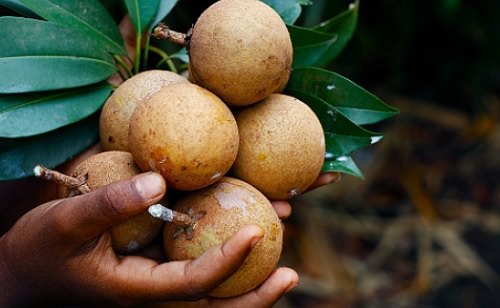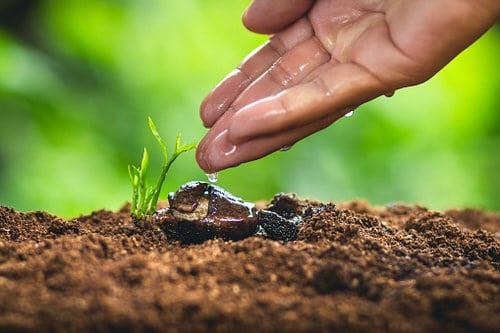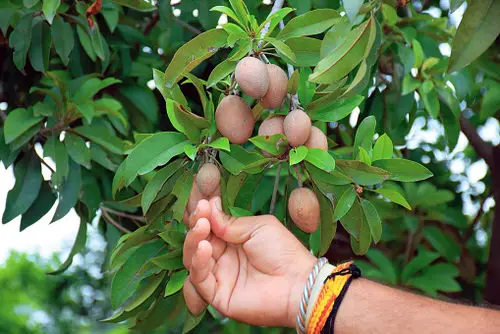Native to the tropics, the naseberry offers sweet fruits. Follow this Growing Sapodilla Tree and Care regimen to grow it easily!

Sapodilla is a tropical evergreen tree, cultivated in many countries for export. This tree can be grown in home gardens and containers as well. You can also plant this exotic fruit tree by following the Growing Sapodilla Tree and Care tips given in this article. Let’s read in detail How to Grow a Sapodilla Tree!
Botanical Name: Manilkara zapota
Soil pH: 6.0-8.0
USDA Zone 4-11
Common Names: Naseberry, chikoo, chiku, dilly
Check out our article on growing mangosteen here.
What is Sapodilla?

Sapodilla is also known as sapota, chikoo, naseberry, or nispero. It is a slow-growing and long-living evergreen tree from Mexico (Yucatan Peninsula) and Central America. The tree is primarily cultivated in India, Pakistan, Thailand, Malaysia, Bangladesh, and Vietnam.
Sapodilla grows up to 20-60 feet. In the wilderness, the tree can reach up to 100 feet (30 m) high. The trunk produces hard bark with gummy white latex known as chicle; the dark green leaves are oval to elliptic shaped with bell-like flowers.
The tree forms 2-3 inches (5-8 cm) diameter berries that have a grainy, juicy pulp of pale yellow to an earthy brown color, with 1-6 hard black seeds. They have a sweet and malty flavor and are a rich source of fructose and sucrose. This nutritious fruit also contains a good amount of folate, niacin, vitamin C and A, and is also high in iron, copper, and potassium.
Best Sapodilla Varieties
- Silas Woods is a dwarf variety that can be maintained to 4-5 feet in height. It is cold-resistant and ideal for containers.
- Alano is another good option for containers. The fruits from this tree are 2-3 inches in diameter and have a fine texture and sweet taste.
- Hasya is a Central American variety that forms football-shaped yellow-red fruits with few seeds.
- Makok can reach up to 2-3 feet tall. It produces smooth brown flesh with a sweet aroma.
- Morena is a Mexican variety; the tree can grow up to 4-5 feet in containers. It produces hard fruits in half red half caramel shade with an exceptional taste.
- Tikal is a Central American variety. It grows tall but can be pruned 2-3 feet. It forms small, elongated, fine-textured fruits.
- Molix is a Mexican variety that grows up to 3-4 feet tall. It produces exceptionally sweet, red-colored fruits.
Sapodilla Tree Propagation

You can propagate sapodilla through seeds sowing them in a pot or directly in the garden soil. Though some gardeners are also known to use grafting and other methods. But, growing from seeds might take about 6-9 years to grow into a sapodilla tree producing fruits. However, getting a young, established sapodilla tree from a nursery will save you a lot of time.
The perfect time for growing sapodilla is during late summer and early fall. It grows well in humid or arid environments.
Place the nursery-brought plant upright, bury the roots properly, and pack it with soil. Spread a fine layer of compost over the soil as this will work as a mulch for the young tree. Water the plant evenly, avoiding stems and leaves. Use a bamboo stick or wooden stake to give support to the growing tree.
Container Size
Take an 18-24 inches diameter pot with drainage holes. Wooden boxes and whiskey barrels can also be used.
Requirements for Growing Sapodilla Tree

Location
For the tree’s best growth and fruit production, choose a site that gets plenty of bright sunlight. The location must also be free of any other trees as sapodillas may get large if not pruned to keep their size in check.
Soil
Use organically rich, well-draining, and fertile soil. If you are using garden soil for growing sapodilla trees, blend it with equal amounts of sand and perlite. The pH of the soil should be around 6 to 8.
For the homemade potting mix, combine equal quantities of peat moss, bark, sand, perlite, or vermiculite, with organic compost. The tree does exceptionally well in the highly calcareous soil of south Florida.
Water
You will have to water the newly planted sapodilla on alternate days for the first week and twice a week after a month for the next 6-8 months. Once the tree gets established and is 4-5 years old, it will not need frequent watering.
Note: During dry months, proper watering will increase fruit production, though mature trees require very less watering.
Sapodilla Tree Care

Pruning
If you notice young trees to be leggy with fewer lower branches, prune the top part. This will induce lateral bud break on the lower trunk. As the tree matures, you will only have to prune out the damaged, diseased branches or dead wood.
Do not cut out the lower branches. Keep the height to about 10-14 feet.
Mulching
Mulching helps in maintaining the moisture of the soil and protects the roots in freezing temperatures. Mulch with a 3-5-inch layer of bark or wood chips. For fully grown trees, keep the mulch 8-12 inches away from the bark.
Fertilizer
Feed the plant with an all-purpose, 5-5-5 fertilizer, every 8-10 weeks during the first year as per the instructions on the label. It will provide nutrients. For well-established trees, use 2.5 to 5.0 lbs of fertilizer 2 to 3 times a year. Apply it at the base of the tree.
Pest and Diseases
Be careful about Caribbean fruit fly, green shield scale, Cuban may beetle, pustule scale, and leafminer. In diseases, look out for leaf rust. Use an organic fungicide to control the infection.
Harvesting and Storage

Wait until some fruits drop from the plant. Start harvesting those of similar size from the tree. Another way to make out if the fruits are ready to harvest is skin color. When it changes its color from brown to amber, they’re ready to be picked.
Also, scratch the surface of the skin, if it is tan in color, the fruits are ripe. But if it is green or oozes latex, it indicates an unripe fruit.
Sapodilla can be stored in the refrigerator for more than a week.
Sapodilla Facts and Uses
- The tree is famous for the white gummy sap, in the bark called chicle. Long ago, the Mayas and Aztecs boiled the ‘chicle’ sap, molded it in blocks, cut it into small chunks to chew as chewing gums.
- The fruit tastes best when eaten fresh.
- The pulp is also famous to make sherbets, milkshakes, and ice creams.



Hi,
My Sapodilla tree had buds and flowers but just could not be pollinated for a fruit even I tried to squeezed while it was a flower.
I deeply appreciate if there is a tip.
Regards,
Paul
Just sharing if you agree:
Well, I might have found a way to pollinate a Sapodilla flower and it becomes a fruit by watering a lot (more than I thought, of course the drainage and sunlight are a must), even without squeezing the flower. Because I saw my Sapodilla tree has some small fruits.